Overview of Digital Transformation Types
Manish Kumawat
Last Updated on: 07 October 2025
Today, the era itself is called the digital era, where people spend the majority of their time on digital platforms and perform various activities with the assistance of digital tools. In the last 20 years, we have seen a great shift in daily life from traditional methods to the digital realm, driven by various Digital Transformation Types that continue to reshape industries, services, and everyday routines.
Remember when booking a flight meant hours spent in a travel agency, searching through paper schedules and waiting for confirmation? Or how about ordering groceries, a task that required a physical trip to the market, a cart, and a long checkout line?
Nowadays, there are countless digital platforms that make these boring and time-consuming tasks easy. The magical thing about this digital transformation is that it is beneficial for both businesses and customers. Companies in various industries are saving thousands of dollars and making millions with this transformation. Efficiency, convenience, and cost-effectiveness are just a few of those advantages.
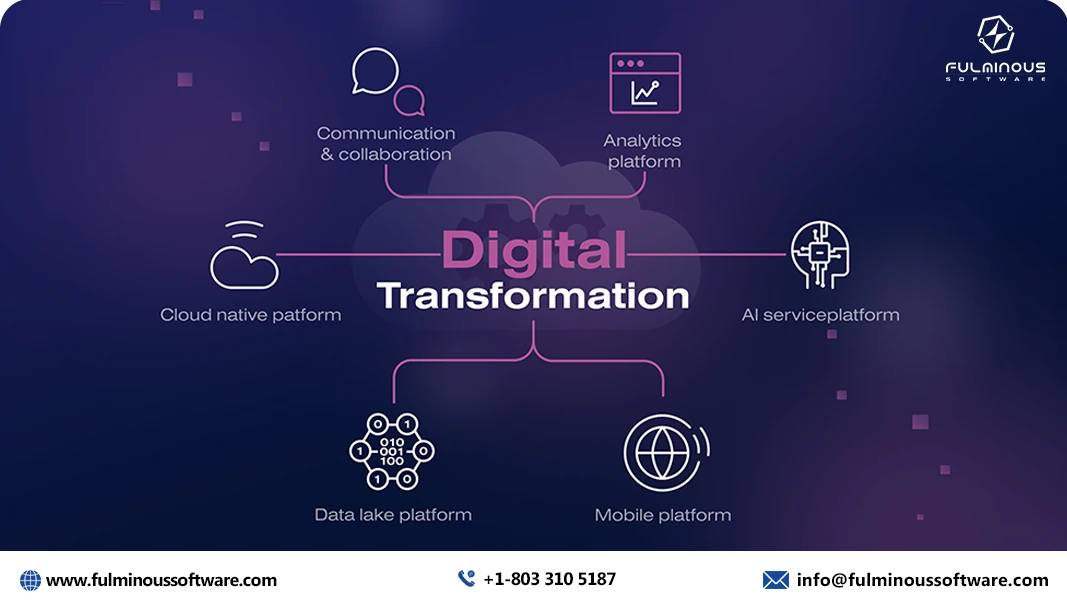
As the technologies that drive digital transformation evolve day by day, businesses are always seeking ways to implement the best practices. Those businesses with a deep awareness of the countless advantages of digital transformation are ready to spend a valuable amount on their digital transformation. At the same time, businesses need to know the types of digital transformation too.
Here we will see the different types of digital transformation and how they are changing businesses and creating exciting new opportunities.
What is Digital Transformation?
Imagine if you lived in a world where everything was done the old-fashioned way — like sending letters to your friends instead of texting them, or using a big paper map instead of Google Maps to find places. That's how the world was a few years ago. For example, a manufacturing business faced plenty of challenges including regular downtime, machine failures, overspending in marketing, and so on. But today things have changed as various technologies have become a huge part of everyday life.
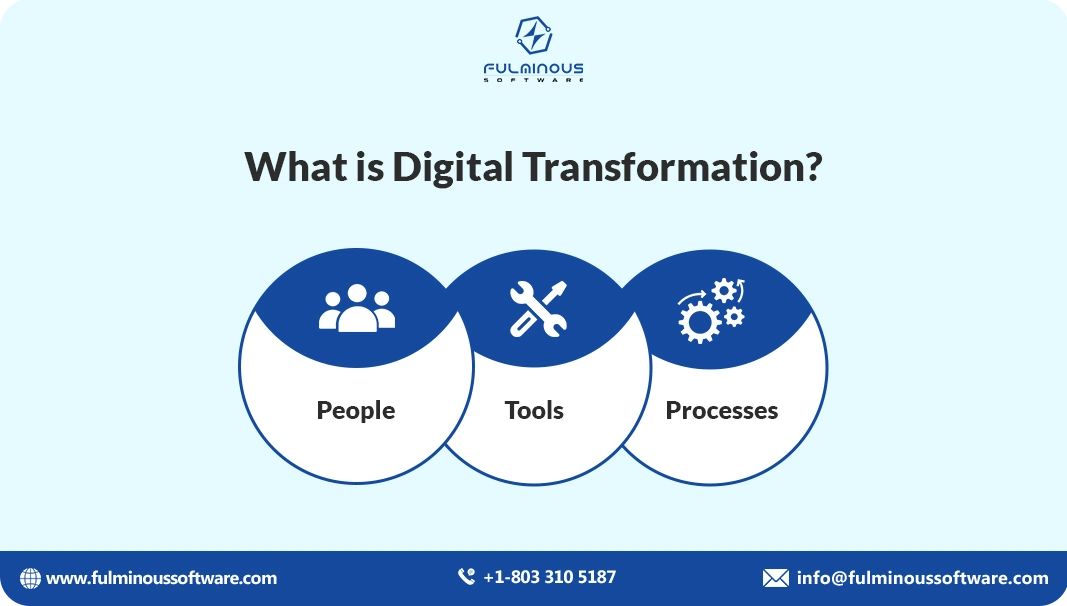
Digital Transformation is all about changing traditional ways of doing things to using digital tools like computers, apps, and the internet. It's like upgrading from an old bicycle to a shiny new electric scooter that gets you places quicker and with less effort.
When businesses, schools, governments, and even families use these tools to make life better and more efficient, it's called Digital Transformation.
Benefits of Digital Transformation for Customers and Businesses
Now that we know the different types of digital transformation, you might be wondering: Why is this all so important? Digital transformation efforts have multi-dimensional benefits. It helps businesses do their jobs more smoothly as well as gives customers a better experience.
Benefits of Digital Transformation for Customers:
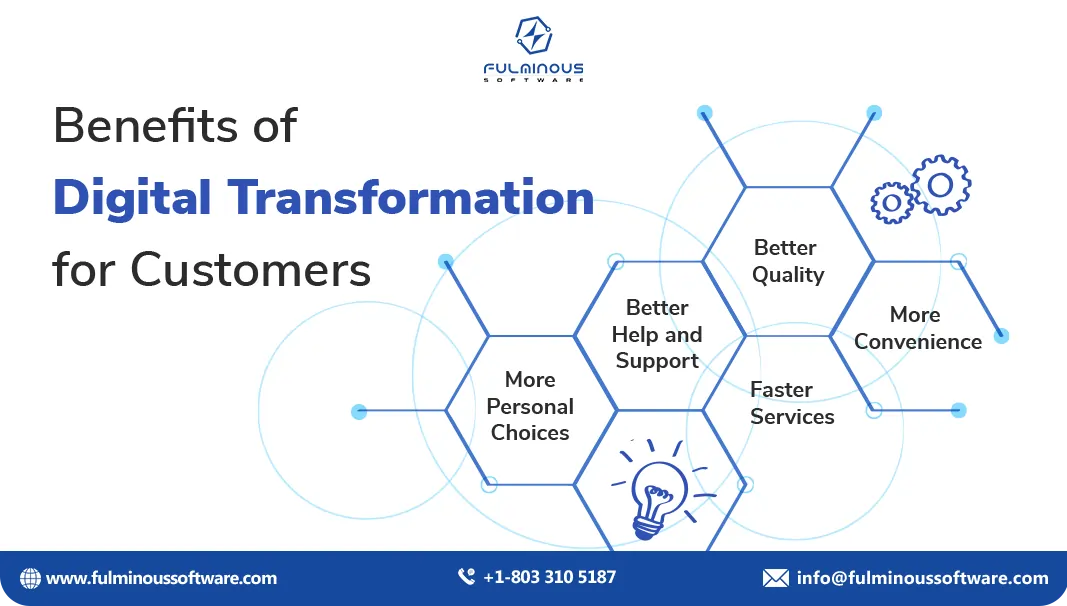
1. Faster Services
Digital transformation helps businesses do things faster. Instead of waiting in line or on the phone, customers can get things faster online. For example, you can order food or buy toys online, and they will be delivered right to your house.
Example: When you order food through an app, it arrives much faster than calling a restaurant and waiting.
2. More Personal Choices
With new technology, businesses can understand what you like and show you things you might enjoy. This makes shopping and using services easier because everything is just for you.
Example: If you watch a lot of superhero cartoons, Netflix might suggest more superhero shows for you to watch.
3. Better Help and Support
If you have a question or problem, digital tools make it easier for businesses to help you. Many businesses now have online chat systems that answer your questions quickly, even at night.
Example: If you need help with your new toy, you can chat with a helper online instead of waiting for a phone call.
4. More Convenience
With digital tools, you can do things from home without going anywhere. You can shop, book appointments, or play games without leaving your room.
Example: You can buy clothes or toys online and have them delivered to your home instead of going to the store.
5. Better Quality
With technology, businesses can make sure their products and services are better. They can use digital tools to check if things are working well, which means customers get better quality.
Example: When you buy a video game, you can check the reviews online to see if it’s fun before you buy it.
Benefits of Digital Transformation for Businesses:
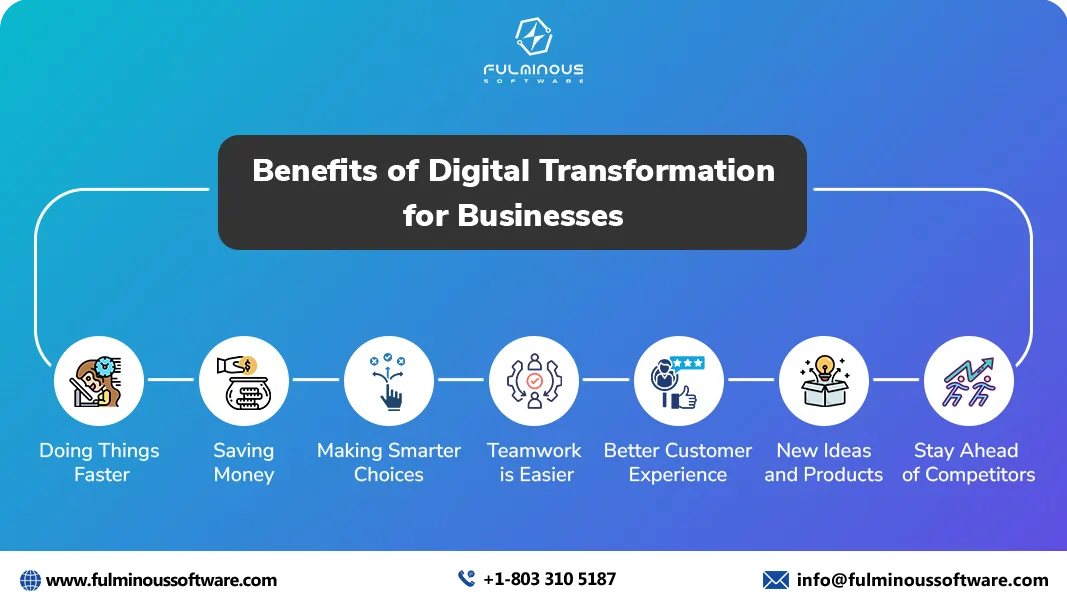
1. Doing Things Faster
Digital transformation helps businesses get their work done faster and easier. Instead of doing everything by hand, businesses can use computers to do some jobs automatically. This saves time.
Example: A store can use a computer to check how many toys they have, so they know when to order more without checking every toy manually.
2. Saving Money
Using digital tools can help businesses save money. They don’t need to spend as much on things like big buildings or paying lots of people to do things by hand.
Example: A company can sell toys online and doesn’t need a big store, so they save money on rent.
3. Making Smarter Choices
Businesses make better decisions with this transformation. By looking at data (like what customers buy or what’s popular), they can make good choices for the future.
Example: A toy store can see that many people are buying a certain kind of toy, so they decide to sell more of them.
4. Better Customer Experience
Digital transformation helps businesses treat customers better. Faster service, giving personalized recommendations, and making shopping or using services more fun are the major benefits.
Example: An online store can suggest toys you might like based on what you’ve bought before, making shopping easier for you.
5. Teamwork is Easier
Businesses can use technology to help workers talk to each other, even if they are far away. Working together online, sharing ideas, and getting things done more quickly are other benefits.
Example: People in different cities can have a meeting online using a video call, so they don’t need to travel far.
6. New Ideas and Products
Digital tools make it easier for businesses to come up with new ideas. Businesses can try out new methods of doing things and create new products for customers.
Example: A company might come up with a new app where you can play games and also learn things, giving customers something new and exciting.
7. Stay Ahead of Competitors
Businesses can make better products or offer cooler services and stay ahead of other companies that aren't using the latest tech.
Example: A store might offer fast delivery or easy online returns, which makes it more attractive than other stores that don’t offer those features.
Types of Digital Transformation
There are several types of digital transformation. Each one has its own process and helps people or businesses in different ways. From the point of view of businesses, you need to know about each one and see its benefits.
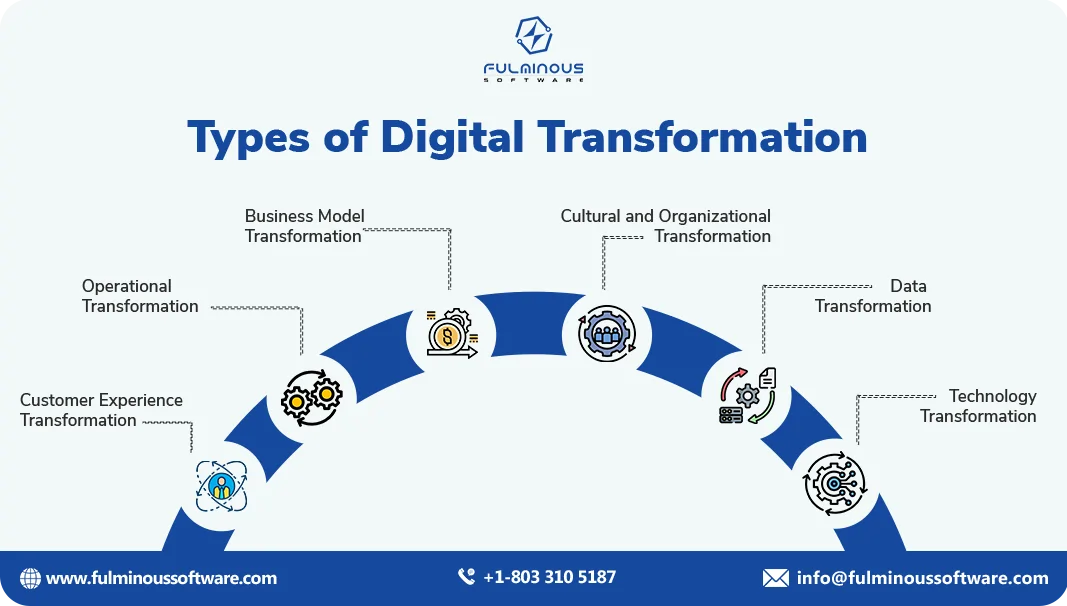
Let’s go through the main types of digital transformation:
1. Customer Experience Transformation
Think of yourself going to a store kilometers away to buy your favorite toy! What about instead of walking into the store, you can order it online and have it delivered to your home? The second one is more comfortable, right? See, this one is a fine example of how businesses use the latest technologies of digital transformation to make customers happy. This type of change is called Customer Experience Transformation.
Making your customers amazing, satisfied, comfortable, and happy is what Customer Experience Transformation deals with. It's like when a store makes a special app where you can see pictures of toys, read reviews, and find discounts. Or when a restaurant lets you order food from your phone instead of waiting in line.
Example: Businesses provide top-class 24/7 customer service with the help of AI-powered chatbots in Digital Transformation.
Benefits:
- Faster Service: Customers can get products and services quickly, whether it's by ordering online or using an app.
- More Convenience: You don't have to leave your home to buy things or get help; you can do it all from your phone or computer.
- Personalized Experiences: Businesses can show you things you like based on your past choices, making shopping more fun.
- Easier Communication: You can get help anytime through chatbots or customer service apps, instead of waiting on the phone or in line.
- Better Satisfaction: Customers feel happier because everything is easy, quick, and meets their needs.
Cost Estimate:
- Low-End: Can be as low as a few hundred dollars for simple improvements (like upgrading a website or creating an app).
- High-End: Can cost thousands or even millions of dollars for larger projects, such as creating a new app, implementing chatbots, or redesigning the entire customer experience with advanced technologies like AI.
What You Might Pay For:
- Website or app development
- User experience (UX) design
- Customer service tools like live chat or automated support systems
- Marketing and personalization tools
2. Operational Transformation
Now, think about a factory that makes toys. In the old days, workers had to do everything by hand. This took a long time, and sometimes mistakes happened. The assistance of computers and robots has changed the scenario. The factory can work much faster and make fewer mistakes. This overall change is Operational Transformation.
Operational Transformation means changing the way businesses do their everyday tasks from every angle. Computers, robots, trending technologies, and smart software automate boring tasks and make everything run fast, cost-effective, efficient, and smoothly. It’s like getting a robot to do your homework – it’s faster and makes fewer errors than doing it yourself!
Example: Manufacturing businesses save a huge money with the emergence of AI and IoT by predictive maintenance. Nowadays they run fully automated factories.
Benefits:
- Faster Service: Customers can get products and services quickly, whether it's by ordering online or using an app.
- Fewer Mistakes: Reduces human errors, ensuring better quality products and services.
- Lower Costs: Businesses save money on labor and reduce mistakes that cost money.
- Increased Efficiency: Tasks that once took a long time can now be done in minutes, making businesses run more smoothly.
- Better Inventory Management: Automatically track supplies and alert businesses when they need to restock, preventing shortages.
Cost Estimate:
- Low-End: For small businesses, simple process automation tools might cost a few hundred to a couple thousand dollars.
- High-End: For larger businesses, implementing full automation (like robotics or enterprise software) can cost tens of thousands to millions of dollars.
What You Might Pay For:
- Process automation software
- Supply chain management systems
- Robotics and AI for tasks like manufacturing or inventory management
- Cloud-based software to manage business operations
3. Business Model Transformation
See an example of Business Model Transformation. In traditional methods, you need to conduct events, open stores, or find retail to sell your products. But what if you used an app to let people order products before they even come to your stand? They could pay using their phones, and you could deliver the products to their homes.
Business Model Transformation means changing the overall business model, viewed from every angle. Doing things the same old way may leave behind others. So businesses use new ideas and technologies to change their model for the better. It's like thinking of a brand-new way to sell lemonade, or even selling digital lemonade in a video game!
Example: Think about a car rental service. Instead of going to a physical place to rent a car, businesses like Uber or Lyft changed the business model by letting you use an app to get a car anywhere.
Benefits:
- New Revenue Streams: Businesses can offer new services, like delivery or subscriptions, to make money in different ways.
- More Convenience for Customers: Customers can buy or use products in new, easier ways, such as ordering through an app.
- Wider Reach: Technology allows businesses to reach more customers online, rather than just in physical stores.
- Better Customer Engagement: Companies can keep customers interested by offering loyalty programs or personalized experiences.
- More Flexibility: Businesses can adapt to new trends or customer needs more easily, thanks to new models like online services or digital products.
Cost Estimate:
- Low-End: For smaller changes (like setting up an online store or offering digital products), you might pay a few thousand dollars.
- High-End: Large-scale transformation could cost hundreds of thousands to millions, especially if it involves completely changing the way your business operates (like moving from physical stores to a fully online service).
What You Might Pay For:
- New business platforms (e-commerce, subscription services)
- Software for managing new services or revenue streams
- Marketing and customer acquisition for new business models
4. Cultural and Organizational Transformation
This type of transformation is about changing the way people think and act within a company. It’s like when a school decides to use tablets and laptops for learning instead of only using paper books. Cultural and Organizational Transformation happens when businesses or schools want their people to think differently and use new tools.
In this transformation, just like Fulminous Software encourages and assists the employees to learn new technologies and get certified, companies encourage their employees to learn new skills, work together better, and be open to trying new technology. It’s like when your teacher shows you how to use a new app for math – everyone learns together, and soon everyone is using the app!
Example: A company might decide that instead of sending emails all the time, employees should use a special chat app to talk to each other.
Benefits:
- Improved Teamwork: Employees can collaborate more easily using digital tools and communication apps, no matter where they are.
- Faster Decision-Making: Using digital platforms for communication allows employees to share ideas quickly and make decisions faster.
- Better Learning and Growth: For better knowledge and to acquire certifications, employees can make use of online training programs and courses.
- Maximum Innovation: A culture of openness and a better organizational environment is a boost for employees to think of new ideas and use technology to improve the business.
- Stronger Company Spirit: Employees feel more connected and motivated when they use modern tools and share common goals.
Cost Estimate:
- Low-End: Small-scale cultural changes might cost a few thousand dollars for training programs, workshops, and internal software tools.
- High-End: A full transformation (like shifting company culture to embrace innovation or implementing major organizational changes) could cost tens of thousands to millions of dollars, especially if it includes hiring consultants or changing company-wide systems.
5. Data Transformation
In the past, businesses didn’t keep track of much data (or information). But today, with computers and the internet, businesses collect tons of data – like how many people visit a website, what products they like, or how much time they spend playing a game. Data Transformation is about taking all this precious information, using it to make smarter decisions, and making benefits out of it.
Artificial Intelligence is the best tech that plays a vital role in this transformation. It’s like looking at a report card and figuring out which subjects you need to work on and which ones you’re doing great at!
Example: When you watch a video on YouTube, the site keeps track of what videos you watch and suggests new ones based on what you like.
Benefits:
- Accurate Decision-Making: Businesses can use data to make smarter choices about products, services, and marketing.
- Personalized Offers: Data helps businesses understand what customers like, so they can offer things that match their preferences.
- Improved Customer Satisfaction: By analyzing data, businesses can improve their services and products based on customer feedback and behavior.
- Predict Trends: Data helps businesses predict what customers might want next, so they can prepare ahead of time.
Cost Estimate:
- Low-End: Small businesses can start with simple data analytics tools for around a few hundred dollars to a few thousand dollars.
- High-End: For advanced data transformations (like big data analytics or machine learning), the cost can rise to tens of thousands to millions of dollars.
What You Might Pay For:
- Data storage systems (cloud services like Amazon Web Services, Google Cloud)
- Business intelligence (BI) tools (like Tableau or Power BI)
- Data security tools to protect customer information
- Data analysis and AI tools to get insights from data
6. Technology Transformation
Technology is always changing. Today a manufacturing factory starts using robots to help pack your products and send them to your house. Or when an e-commerce textile business uses super powerful techs to show how you will look when you wear their dresses. New inventions, IoT, robots, ML, and artificial intelligence (AI), make our lives easier.
From the name itself, we can understand Technology Transformation deals with overall changes using trending technologies. Think about a smart speaker, like Alexa or Google Home. It uses technology to talk to you, play music, or answer questions.
Example: Manufacturing businesses use IoT and artificial intelligence to make their factories fully automated. Also, businesses use trending technologies in each task.
Benefits:
- Better Products and Services: New technology helps businesses create more exciting, high-quality products.
- Improved Efficiency: Advanced tools and machines make production faster, cheaper, and more accurate.
- Enhanced Customer Experience: New technologies, like smart speakers or apps, make using products and services easier and more fun.
- Competitive Advantage: Businesses that use the latest tech can stay ahead of others who haven’t adopted these tools.
Cost Estimate:
- Low-End: Small-scale tech upgrades (like adopting new software tools or small hardware updates) could cost a few thousand dollars.
- High-End: Large tech transformations (like implementing new hardware, adopting AI, or upgrading entire systems) can cost hundreds of thousands to millions of dollars.
What You Might Pay For:
- New software or apps
- Hardware (servers, workstations, smart devices)
- Advanced technologies like AI, machine learning, or IoT (Internet of Things)
- IT infrastructure upgrades (for better storage, security, or connectivity)
Which Type of Digital Transformation to Choose First?
First of all, remember: Every digital transformation initiative is a must-do for business, the more you invest in each the more your business achieves success. As you have seen the benefits, you can’t ignore any one digital transformation.
The second important thing is that digital technology transformation is the most important compared to all the others. This transformation is just like changing your business with supernatural powers. With this transformation, high growth in ROI is assured.
Even though every type is relevant for businesses, you can do it as per your needs and budget. It depends on your business’s needs. If you want your customers to have a better experience and keep coming back, start with Customer Experience Transformation.
If your business is slow or making mistakes, Operational Transformation might be the best choice. But, if you need to offer new ways to make money, Business Model Transformation will help you do that. If you want to improve how your team works, try Cultural and Organizational Transformation.
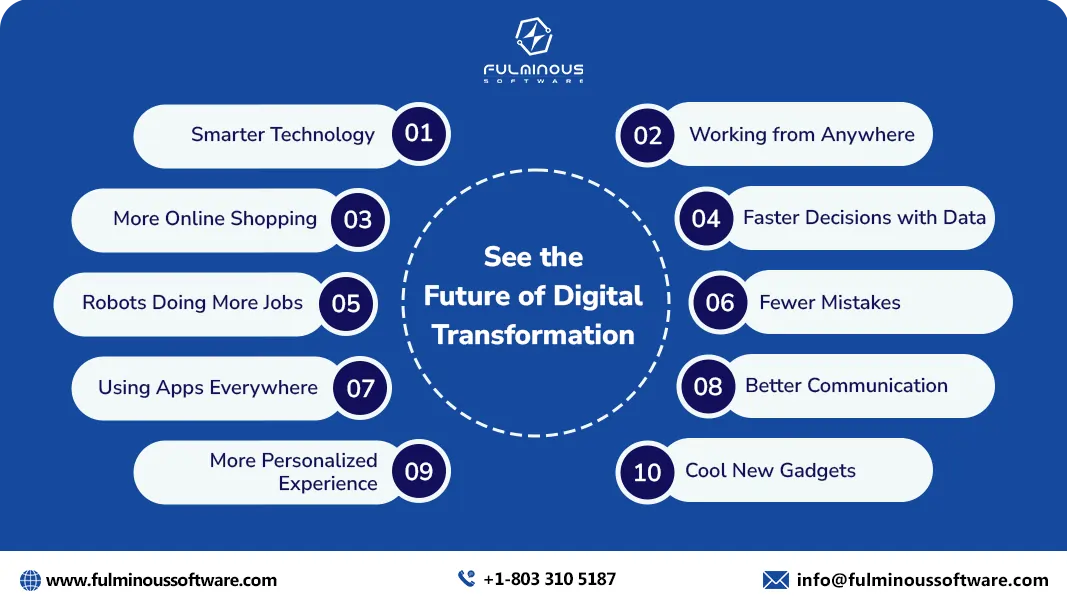
Conclusion
Digital transformation is a big change, but it’s a good one. Businesses can bring a great change in their overall functioning with these changes. Each one has its own specific features and benefits. The benefits are not only for businesses but also for customers.
All types of digital transformation including Customer Experience Transformation, Operational Transformation, Business Model Transformation, Cultural and Organizational Transformation, Data Transformation, and Technology Transformation have their own impact on business.
A clear understanding of types of digital transformation will guide you to the next level of business growth. Because each transformation is necessary for your business. If you miss these trends and changes, you may be left behind by other competitive businesses.
As most businesses are not aware of all these types of transformations, you need assistance from a leading digital transformation provider. If you want to know more about these types of digital transformation, digital transformation strategy, and successful digital transformation, contact us.
FAQs
- 1. What is digital transformation?
- Digital transformation means using technology, like computers and apps, to make work and life easier and faster.
- 2. How does digital transformation help businesses?
- It helps businesses save time, money, and effort, making things faster and more efficient for everyone involved.
- 3. What is customer experience transformation?
- It’s when businesses use technology to make shopping or services easier and more fun for customers.
- 4. How does digital transformation help customers?
- Customers get faster service, more choices, better help, and can do things from home more easily.
- 5. What is operational transformation?
- Operational transformation means businesses use technology to make their work quicker, smarter, and with fewer mistakes.
- 6. What is business model transformation?
- Business model transformation is when companies change how they make money by using new ideas or technology.
- 7. Why is data important in digital transformation?
- Data helps businesses understand customers better and make smarter choices to improve products and services.
- 8. What is technology transformation?
- Technology transformation means businesses use new tools and machines to work better, faster, and provide better products.
- 9. What is cultural and organizational transformation?
- It’s when a company encourages employees to learn new skills and work better together with digital tools.
- 10. How can digital transformation change a business?
- It makes a business run more smoothly, helps with customer satisfaction, and allows companies to grow faster.
HIRE A TOP SOFTWARE DEVELOPMENT COMPANY

 Verified
Expert in Software & Web App Engineering
Verified
Expert in Software & Web App Engineering
I am Manish Kumawat, co-founder of Fulminous Software, a top leading customized software design and development company with a global presence in the USA, Australia, UK, and Europe. Over the last 10+ years, I am designing and developing web applications, e-commerce online stores, and software solutions custom tailored according to business industries needs. Being an experienced entrepreneur and research professional my main vision is to enlighten business owners, and worldwide audiences to provide in-depth IT sector knowledge with latest IT trends to grow businesses online.
Partner with Top-Notch Web Application Development Company!
Discuss your Custom Application Requirements on info@fulminoussoftware.com or call us on +1-903 488 7170.
15 Days Risk-Free TrialRecommended Articles


